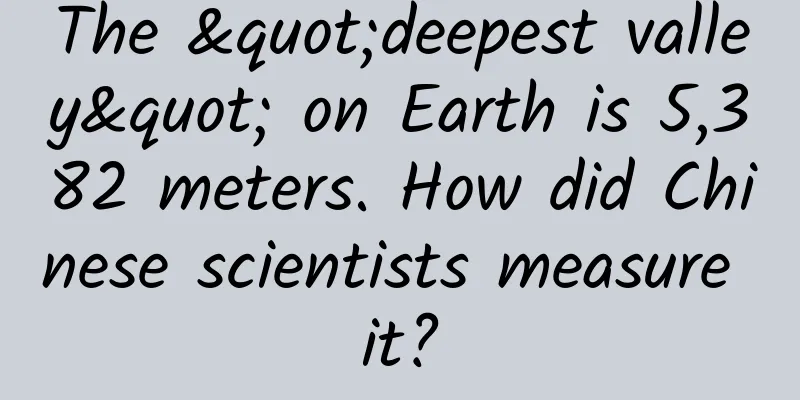The "deepest valley" on Earth is 5,382 meters. How did Chinese scientists measure it?

|
On April 17, 1994, Chinese scientists confirmed for the first time that the Yarlung Zangbo Grand Canyon, with a maximum depth of 5,382 meters, is the deepest canyon on Earth. The world's highest river, the Yarlung Zangbo River, runs on the Qinghai-Tibet Plateau, the roof of the world. After it flows through Pai Township in Tibet, the river suddenly narrows and makes a horseshoe-shaped turn around Mount Namjagbarwa. The canyon is rushing and sloping down, heading straight into India. In October 1998, the State Council officially named the section from Pai Township in Tibet to the southern foot of the Qinghai-Tibet Plateau as the "Yarlung Zangbo Grand Canyon". Looking back at the Chinese people's exploration of this world's largest canyon, it was difficult and tortuous, but also fruitful. Adventure Road The Yarlung Zangbo River Grand Canyon still holds a Guinness World Record for being the deepest canyon on Earth. This means that on the Qinghai-Tibet Plateau, known as the roof of the world, there are not only the highest mountains in the world, but also the deepest river canyons in the world. This strong contrast of terrain, one high and one low, creates a magnificent landscape that is rare in the world. According to the latest data released by the State Bureau of Surveying and Mapping in April 1999, the average length of the Yarlung Zangbo Grand Canyon is 504.64 kilometers, the average depth is 2,268 meters, the deepest valley floor is 6,009 meters, the average width is 113 meters, and the narrowest point is 35 meters. In fact, the canyon was formed to its current size as early as 10,000 years ago. However, due to its deep, steep, narrow and rainy ditch, it has created great difficulties for scientific explorers. In 1973, Guan Zhihua, Yang Yichou and other Chinese scientists set out from Pai Township, Tibet, and opened the prelude to scientific research in the Grand Canyon area. Due to the steep mountains, they could not continue to explore along the river valley, so they had to cross the mountains to Zhaqu. Later, Chinese scientists explored there many times and achieved gratifying results. On April 17, 1994, Chinese scientists, referring to past survey data and after careful calculation and analysis, confirmed for the first time that the Yarlung Zangbo Grand Canyon is the largest in the world and announced this major discovery to the world. In order to confirm the unparalleled status of the Yarlung Zangbo Grand Canyon in the world, Chinese researchers made a standard section at the canyon of the 7,782-meter Nanga Bawa Peak and the 7,234-meter Jiala Bailei Peak based on a 1:50,000 topographic map and aerial survey map, and then made two comparative sections across the Grand Canyon. The calculation results show that the Yarlung Zangbo Grand Canyon, which cuts through the Himalayas, has an average depth of more than 5,000 meters, and the deepest place is 5,382 meters. Later, Gao Dengyi, a researcher at the Institute of Atmospheric Physics of the Chinese Academy of Sciences, said: "In 1973, 1974, 1975, 1982, 1983 and 1994, nearly 100 to 200 scientists have conducted scientific surveys and indeed achieved a lot. However, there is a big bend in the Yarlung Zangbo River, and the area about 100 to 200 kilometers at both ends is too steep to pass." The terrain of this bend is steep and it is also the core section of the canyon, which has never been visited by humans. At that time, Gao Dengyi and many scientists were full of curiosity about this area. With the desire and dream of creating the "first" for the Chinese people, from late October to early December 1998, they completed the river valley survey between Baimagouxiong-Xixingla-Zhaqu-Bayu-Gandai. The expedition team was divided into three teams and a waterfall team, and finally successfully completed the expedition. This expedition was also rated as one of the top ten scientific and technological advances in China in 1998. The Secrets of the Grand Canyon Did the Chinese try to cross the Grand Canyon so many times just to win the title of "world's first"? Of course not. Gao Dengyi said that crossing the Yarlung Zangbo Grand Canyon is very important for scientific research. First, it is one of the three major gene banks in China. Second, the water vapor transport function of this place is very important for the climate environment and human activities. Third, its biological gene bank is also very important. The environment in the Grand Canyon is pure and the landscape is beautiful. The special geographical location and topographical conditions make it the largest channel for transporting water vapor from the Qinghai-Tibet Plateau to the hinterland. The continuous warm and humid water vapor from the Indian Ocean is transported to the inland of the plateau along with the southwest monsoon, forming a special climate in southeastern Tibet. The northernmost boundary of tropical climate zones and natural zones in the Northern Hemisphere is located at 23.5 degrees north latitude on average, but in the Grand Canyon, both have moved 5.5 degrees northward to 29 degrees north latitude, the highest in the world. The water vapor channel has evenly distributed climate zones and natural zones from tropical, subtropical to Arctic on the north and south slopes of the mountains in the Grand Canyon, which was praised by Academician Ye Duzheng as "a microcosm of global climate and environmental change." The water vapor channel also nourishes the monsoon marine glaciers, making the glaciers and forests blend together to create a spectacle. It is also a refuge for ancient species, preserving a large number of ancient species and leaving behind many "living fossils", such as mosses, gymnosperms, and so on. It is also the fifth largest river in my country, and its hydropower reserves are second only to the Yangtze River. The natural water reserves here are as high as 68.81 million kilowatts, and the hydropower reserves per unit river section are 138,600 kilowatts/kilometer, ranking first in the world. The Grand Canyon is rich in species of animals, plants, microorganisms and other resources. It is a "treasure house of five types of resources" and a "natural museum of plant types." Scientific achievements The Chinese scientific expedition team not only successfully completed the crossing, but more importantly, brought fruitful scientific research results. Gao Dengyi introduced that the riverbed of the Yarlung Zangbo Grand Canyon is composed of granite, and the river water cannot destroy the riverbed to form waterfalls. After confirmation, the slope of the river section here is the highest in the world. The scientific expedition team further investigated the water resources in the Grand Canyon area, adding scientific basis for rational development and utilization. The scientific expedition team also specially established three geodetic benchmarks and obtained precious surveying and mapping data. After analysis and research, it once again confirmed that the Yarlung Zangbo Grand Canyon is the first in the world. The expedition team collected thousands of samples and specimens related to plants, insects, water resources, geology, landforms, atmosphere and glaciers, filling the scientific gap in the core river section and achieving more important scientific results after indoor analysis. The specimens of Pterygidae found in the canyon area and the yew forests found in the Xixingla-Zhaqu-Gandai area have higher scientific significance and economic value. The Chinese people's successful crossing of the Yarlung Zangbo Grand Canyon was considered by academicians such as Ye Duzheng, Liu Donglai and Sun Honglie to be one of the major geographical discoveries of the 20th century. It demonstrated the Chinese people's national spirit of daring to explore the unknown and also took an important step for mankind to understand nature. |
Recommend
The province in China that is best at eating spicy food is actually here! (Not Hunan, Sichuan, or Jiangxi)
What is the "chili ceiling"? If you go ...
The secret code of the top stock market
Introduction to the top-level board science resou...
Celebrity X-Files: Alan Turing | Celebrating Turing's 110th Birthday
Alan Turing, a British computer scientist, mathem...
The simplest video chat tool Xiaoyu accompany robot experience at home
With the help of technology, being able to see th...
Serialize the Intent and pass it like a Uri!!!
[[207121]] 1. Do you really need to create a new ...
Ten lessons from a novice to a master of public speaking
Ten lessons to turn a novice into a master of publ...
Regarding the China Eastern Airlines crash, all this "information" is false!
Around 14:38 on March 21 China Eastern Airlines f...
The Medical Insurance Chamber of Commerce has released a list of medical supplies manufacturers that have obtained foreign standard certification or registration
This list was published by China Chamber of Comme...
Snap! Not Whoosh! The super function of Perseverance's super camera
'Crack!' Not 'Whoosh!': Persevera...
Kuaishou Advertising Creative Guide for 2019!
Driven by multiple forces including users, platfo...
How to plan Baidu bidding advertising?
Doing Baidu search promotion (bidding promotion) ...
WeChat 8.0.10 is fully updated. These 7 features are particularly useful. Have you discovered them?
This time, WeChat version 8.0.10 has been fully u...
Vertical lines and white spots on the nails are a "sign of death"? 4 conditions to be alert to →
In life, most people have smooth and rosy nails, ...
Marketing activity planning ideas and misunderstandings!
What kind of marketing activities will be more ef...
How to leverage the college entrance examination for marketing?
Every year at the end of May and the beginning of...









